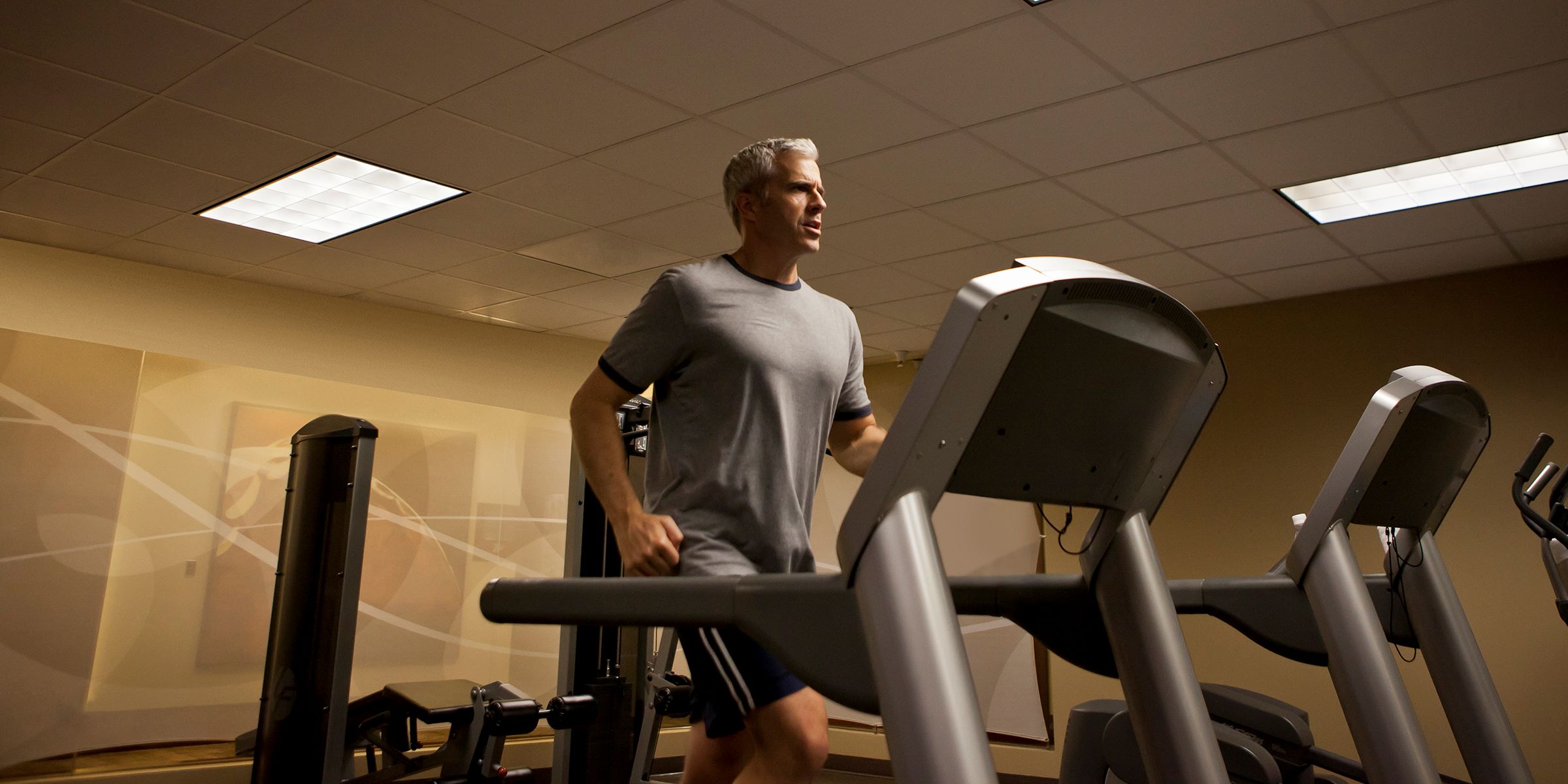

Featured
What Is METs On A Treadmill
Modified: October 25, 2023
Looking to get featured on a treadmill? Find out what mets are and how they can help you track your workout intensity.
Introduction
Welcome to the world of fitness! In today’s fast-paced world, maintaining good health and staying fit has become more important than ever. With countless exercise options available, it can be overwhelming to determine which workout routine is best for you. One popular method that combines the measurement of physical activity with cardiovascular exercise is known as METs on a treadmill.
Before we delve into the details of METs on a treadmill, let’s first understand what METs are. MET stands for Metabolic Equivalent of Task, which is a unit used to estimate the amount of energy expended during physical activities. It provides a way to measure the intensity of different exercises based on the calories burned.
A treadmill is a common piece of exercise equipment that allows individuals to walk, jog, or run indoors. It provides a controlled and convenient environment for people to engage in cardiovascular workouts, regardless of weather conditions. The combination of METs and a treadmill creates an efficient and effective way to track and improve your fitness levels.
By using METs on a treadmill, you can measure the intensity of your workout and adjust it to meet your specific goals. Whether you’re aiming to lose weight, improve cardiovascular endurance, or increase stamina, METs on a treadmill can help you monitor your progress and optimize your workouts.
Understanding the benefits and considerations of METs on a treadmill will enable you to make informed decisions about incorporating this exercise method into your fitness routine. In the following sections, we will explore the definition of METs, the benefits of treadmill exercise, and how they can be combined to enhance your overall fitness journey.
Definition of METs
Before we dive into METs on a treadmill, let’s take a moment to understand what METs are. MET stands for Metabolic Equivalent of Task, a measurement used to estimate the amount of energy expended during physical activities.
One MET is equivalent to the energy expended while sitting at rest. Activities with a higher MET value require more energy and are considered more intense. For example, walking at a brisk pace might have a MET value of 3, which means you are expending three times the energy compared to sitting at rest.
METs are commonly used to measure the intensity and energy expenditure of various exercises. They provide a standardized way to compare the intensity of different activities, allowing individuals to gauge the effectiveness of their workouts.
A MET value is assigned to each activity based on the rate of oxygen consumption. This value is then used to estimate the calories burned during that activity. For example, if you perform an activity with a MET value of 5 for 30 minutes, you would have burned five times the energy compared to sitting at rest for the same duration.
Knowing the MET value of an activity allows you to better understand and compare the intensity of different exercises. It enables you to plan and adjust your workouts according to your fitness goals. By tracking the METs of your treadmill exercises, you can monitor your progress, challenge yourself, and make adjustments as needed.
In summary, METs provide a standardized unit of measurement for estimating the energy expenditure of physical activities. Understanding METs is essential in utilizing them effectively on a treadmill to optimize your workout and achieve your fitness objectives.
Treadmill Exercise
The treadmill is a versatile and popular piece of exercise equipment that allows individuals to engage in cardiovascular workouts indoors. It offers a controlled and convenient environment for walking, jogging, or running, making it accessible to people of all fitness levels.
Treadmill exercise provides numerous benefits for overall health and fitness. Here are some key advantages:
- Convenience: With a treadmill, you have the freedom to exercise anytime, regardless of weather conditions or the availability of outdoor spaces. It’s an excellent option for those who prefer indoor workouts or have limited access to safe outdoor areas.
- Controlled Environment: Unlike outdoor running or walking, a treadmill offers a controlled environment where you can adjust the speed, incline, and duration according to your fitness level and goals. This allows you to gradually increase the intensity of your workout and track your progress more effectively.
- Low-Impact Option: Treadmill exercise is gentle on the joints, making it suitable for individuals with joint issues or those who want to minimize impact on their knees, ankles, and hips. The cushioned surface of the treadmill reduces the risk of injuries often associated with outdoor running on hard surfaces.
- Heart Health and Weight Management: Regular treadmill workouts help improve cardiovascular health by boosting heart and lung function. It increases your heart rate, burns calories, and contributes to weight management. Depending on the intensity and duration of your treadmill exercise, you can achieve significant calorie expenditure and fat loss.
- Variety of Workouts: Treadmills come with various features and programs that offer a range of workout options. You can choose from preset programs that simulate different terrains, interval training programs, or create custom workouts tailored to your specific needs.
Treadmill exercise is suitable for individuals of all fitness levels, from beginners to advanced athletes. It provides a convenient and effective way to improve cardiovascular endurance, burn calories, and achieve fitness goals.
When using the treadmill, it’s essential to maintain proper form, starting with a warm-up and cool-down phase to prevent injuries. Remember to always listen to your body and adjust the settings according to your comfort level.
Now that we have explored the benefits of treadmill exercise, let’s move on to how we can combine METs and treadmill workouts to optimize our fitness journey.
Combining METs and Treadmill Exercise
Now that we understand what METs are and the benefits of treadmill exercise, let’s explore how we can combine METs and treadmill workouts to enhance our fitness journey.
Using METs on a treadmill allows you to track the intensity of your workout and determine the energy expended during your exercise session. By adjusting the speed and incline of the treadmill, you can increase the MET value, resulting in a higher calorie burn and a more challenging workout.
Here are some ways to incorporate METs into your treadmill exercise routine:
- Interval Training: Interval training involves alternating between periods of high-intensity exercise and active recovery. By increasing the speed and incline during the intense intervals, you can raise the MET value and challenge your cardiovascular system. This method not only burns more calories during the workout but also boosts your metabolism, allowing for continued calorie burn even after you finish exercising.
- Progressive Overload: To continually improve your fitness levels, it’s essential to progressively increase the difficulty of your workouts. You can achieve this by gradually increasing the speed or incline of the treadmill over time. By monitoring the MET value, you can ensure that you are consistently challenging yourself and pushing your limits.
- MET-Based Workouts: Many treadmills have pre-programmed workouts or settings that target specific MET values. These workouts are designed to help you achieve specific fitness objectives, such as fat burning or endurance training. By selecting the appropriate MET-based workout, you can follow a structured program that aligns with your goals.
- Tracking and Monitoring: Utilize the metrics provided by the treadmill, such as heart rate monitoring and calorie expenditure, to get a comprehensive understanding of your workout’s intensity. Keep track of your MET values over time to track your progress and make informed decisions regarding your training regimen.
By incorporating METs into your treadmill exercise routine, you can make your workouts more purposeful and effective. Not only will you be able to gauge the intensity of your workouts, but you will also have a clear picture of the energy expenditure, helping you align your fitness goals and optimize your training plan.
Before incorporating METs into your treadmill workouts, it’s important to consult with a fitness professional or healthcare provider, especially if you have any underlying health conditions or are new to exercise. They can guide you in setting realistic goals and ensure that you approach your fitness journey safely and effectively.
Now that we’ve explored the combination of METs and treadmill exercise, let’s delve into the benefits that this approach offers.
Benefits of METs on a Treadmill
Combining METs and treadmill exercise offers a multitude of benefits that can greatly enhance your fitness journey. Let’s explore some of the key advantages:
- Accurate Measurement of Intensity: METs provide a quantifiable measure of exercise intensity, allowing you to accurately gauge the energy expended during your treadmill workouts. This information is valuable for tracking your progress, setting goals, and designing a well-rounded fitness plan.
- Effective Weight Management: By monitoring and increasing the MET value of your treadmill workouts, you can burn more calories, contributing to weight loss or maintenance. METs on a treadmill provide a systematic approach to managing your weight and improving body composition.
- Enhanced Cardiovascular Fitness: Treadmill exercise, when combined with METs, offers a highly effective way to improve cardiovascular endurance. By gradually increasing the intensity of your workouts and challenging your cardiovascular system, you can enhance your heart and lung function, leading to improved overall fitness.
- Flexibility and Convenience: The versatility of the treadmill allows you to customize your workouts based on your fitness level and goals. Whether you prefer walking, jogging, or running, you have the freedom to adjust the speed, incline, and duration of your workout. Furthermore, the convenience of exercising indoors on a treadmill provides a consistent and controlled environment for your fitness routine.
- Progress Tracking and Motivation: Incorporating METs into your treadmill workouts enables you to track your progress and measure your fitness achievements. By consistently monitoring the MET values and other metrics provided by the treadmill, you can see tangible improvements over time, which can serve as motivation to continue challenging yourself and reaching new fitness milestones.
By combining METs and treadmill exercise, you can optimize your workouts, improve your fitness levels, and achieve your desired health outcomes. However, it’s important to remember that consistency and proper form are key. Gradually increase the intensity of your workouts, listen to your body, and seek guidance from fitness professionals if needed.
It’s also worth noting that while METs on a treadmill can be a highly effective exercise approach, it’s not the only way to achieve your fitness goals. It’s important to incorporate a variety of exercises, such as strength training and flexibility workouts, to ensure a well-rounded fitness routine.
Now that we’ve explored the benefits of METs on a treadmill, let’s discuss some precautions and considerations to keep in mind when incorporating MET-based treadmill workouts into your routine.
Precautions and Considerations
While METs on a treadmill can be a beneficial addition to your fitness routine, it’s important to take certain precautions and considerations into account. Here are some key points to keep in mind:
- Consult with a Healthcare Professional: Before starting any new exercise program, especially if you have underlying health conditions or are new to exercise, it’s important to consult with a healthcare professional or fitness expert. They can conduct a thorough assessment and provide personalized guidance on incorporating MET-based treadmill workouts safely and effectively.
- Start Slow and Gradually Increase Intensity: It’s important to ease into MET-based treadmill workouts. Start at a comfortable pace and gradually increase the intensity over time. Pushing yourself too hard, too quickly can lead to injuries or burnout. Listen to your body and prioritize proper form and technique over speed or distance.
- Proper Warm-Up and Cool-Down: Before and after each treadmill workout, dedicate time to warm up your muscles and prepare your body for exercise. Similarly, cool down with gentle movements and stretches to help your body recover and prevent muscle soreness. This routine can help reduce the risk of injury and improve overall workout performance.
- Stay Hydrated: Treadmill workouts, especially when combined with higher intensity levels, can result in increased sweating and fluid loss. It’s crucial to stay hydrated before, during, and after your workouts. Drink water regularly and listen to your body’s signals for thirst.
- Adjust Speed and Incline Gradually: As you become more comfortable with MET-based treadmill workouts, you may be tempted to push yourself further by increasing the speed or incline significantly. However, it’s important to adjust these variables gradually to avoid overexertion or strain on your muscles and joints. Allow your body time to adapt to the changes.
- Listen to Your Body: Pay attention to any discomfort or pain during your treadmill workouts. If you experience any sharp or persistent pain, dizziness, or shortness of breath, stop exercising and seek medical attention if necessary. It’s important to prioritize your safety and well-being during your fitness journey.
By taking these precautions and considerations into account, you can minimize the risk of injuries and maximize the benefits of MET-based treadmill workouts. Remember, it’s always better to start slowly and progress gradually than to rush into intense exercise that your body may not be ready for.
Now that we’ve discussed the precautions and considerations, let’s wrap up with a summary of the key points we’ve covered in this article.
Conclusion
In today’s world, where maintaining good health and fitness is a priority, combining METs and treadmill exercise offers numerous benefits for individuals seeking to improve their overall well-being. By understanding what METs are and how they can be applied to treadmill workouts, you can optimize your fitness routine and achieve your desired goals.
METs provide a standardized measure of exercise intensity, allowing you to accurately track the energy expenditure during your treadmill workouts. This information enables you to gauge the effectiveness of your exercises, set realistic goals, and design a well-rounded fitness plan.
Treadmill exercise, when combined with METs, offers a convenient and controlled environment for cardiovascular workouts. It provides flexibility in adjusting the speed, incline, and duration of your workouts. Whether you’re a beginner or an advanced athlete, the treadmill can be tailored to your fitness level.
The benefits of METs on a treadmill include accurate measurement of intensity, effective weight management, enhanced cardiovascular fitness, flexibility, and the ability to track progress and stay motivated. However, it’s crucial to take precautions and considerations into account, such as consulting with a healthcare professional, starting slowly, and listening to your body.
Incorporating MET-based treadmill workouts into your fitness routine can be a valuable addition to your overall health and wellness journey. Remember that consistency, proper technique, and a balanced approach to exercise are key factors in achieving long-term success.
So lace up your sneakers, hop on that treadmill, and embrace the power of METs to enhance your fitness and embark on a path to a healthier lifestyle. Your body and mind will thank you for it!









